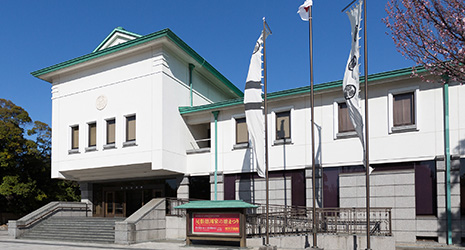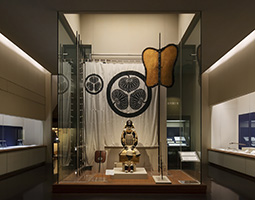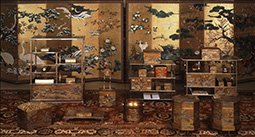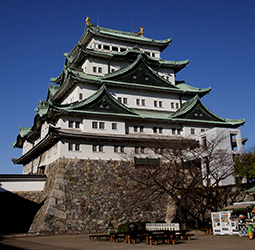INDEX
- English
- 日本語

The Tokugawa Art Museum - English
- 日本語

Detail of National Treasure “The Tale of Genji Illustrated Scrolls”

Suits of armor and swords are among the precious exhibits 
Part of National Treasure the Hatsune (First Warbler) Trousseau 
Nagoya Castle’s main tower keep
December 2020
Keeping the Splendor of Daimyo Culture Alive

There is an expression, “Nagoya owes its prosperity to the castle.” This proud boast dates back to the Edo period (1603–1867), when Nagoya Castle was constructed at the behest of Tokugawa Ieyasu. Another source of pride for Nagoya is the Tokugawa Art Museum, which houses many works of art bequeathed by the castle’s owners, the Owari Tokugawa family.

After establishing the Tokugawa shogunate in 1603, Tokugawa Ieyasu (1543–1616) appointed his three sons as daimyo of the feudal domains Owari, Kishu and Mito. These three branches of the Tokugawa clan came to be known as the Tokugawa Gosanke, or “Three Houses of the Tokugawa.” The senior-most house is the Owari House (corresponding to present-day Aichi Prefecture), its prestige still communicated by the residence of the Owari House of Tokugawa, Nagoya Castle.
Constructed in 1612 at the behest of Ieyasu, Nagoya Castle is partially extant, including the stone walls and gardens. The castle’s main tower keep was restored in 1959 and has come to symbolize Nagoya City in Aichi Prefecture. Approximately three kilometers east of the castle, on the site of the Owari Tokugawa family villa, is the Tokugawa Art Museum.
The Tokugawa Art Museum was opened in 1935 by the nineteenth-generation head of the family, Yoshichika, who established a foundation and donated artifacts with the aim of passing on to posterity the daimyo culture and traditions handed down from generation to generation. The museum houses over 10,000 objects, including 9 designated National Treasures, 59 Important Cultural Properties, and 46 Important Art Objects, encompassing a vast amount of possessions bequeathed by Ieyasu and the cherished belongings of successive heads of the family.

According to Ichihashi Yasuyoshi, the museum’s vice-director, “A particular characteristic of the museum’s collection is that many of the objects have been treasured as Owari Tokugawa family heirlooms in Nagoya Castle so they are well preserved and have well documented historical records. It’s the most comprehensive collection of daimyo culture in any art museum in Japan.”
Among the extravagantly crafted swords, armor, tea utensils, and other artifacts, the Hatsune (First Warbler) Trousseau, designated a National Treasure, is especially gorgeous. This is the bridal trousseau of Chiyohime, daughter of the third Tokugawa Shogun Iemitsu, brought on the occasion of her marriage to the second daimyo of the Owari clan, Mitsutomo. The trousseau comprises over 70 items, such as tebako boxes and cosmetic tools, all exquisite and representing the finest examples of the makie lacquerware technique dating back some 400 years. Also included in the museum’s collection is the National Treasure “The Tale of Genji Illustrated Scrolls,” a masterpiece painted in the first half of the twelfth century depicting The Tale of Genji, one of the world’s first pieces of long-form realistic fiction.

As well as exhibiting these precious treasures, with items from the collection being frequently rotated, the Tokugawa Art Museum regularly hosts events that allow visitors to try on replica swords and armor, as well as experience traditional entertainments such as “Monko” (distinguishing different types of incense) and “Kaiawase” (matching pairs of clam shells decorated with painted scenes inside).
“One of the highlights of the exhibition room is a partial reconstruction of the interior of the Ninomaru Palace in Nagoya Castle, where the head of the Owari Tokugawa family resided, based on historical documentary evidence. You can deepen your understanding of daimyo culture even more by combining a visit to the museum with Honmaru Palace in Nagoya Castle, which was used as accommodation for the shogun and was faithfully restored based on the original plans in 2018,” says Ichihashi.

The city plan of present-day Nagoya is still based on the layout centered on Nagoya Castle during the Edo period (1603–1867). The subdivisions of Shirakabe, Chikaramachi and Shumokucho were once lined with samurai residences and they retain aspects of Edo times such as their names and streetscapes. Kenchu-ji Temple, the family temple of the Owari Tokugawa, and Atsuta Jingu (Atsuta Shrine), where generations of famous warlords worshipped, also tell the history of Nagoya. Visitors to Nagoya Castle are greeted by the Nagoya Omotenashi Bushotai (Nagoya Hospitality Warriors) dressed in samurai costumes, a fun and friendly initiative of Nagoya City. Nagoya is still brimming with the charm of traditions bequeathed by warlords.

